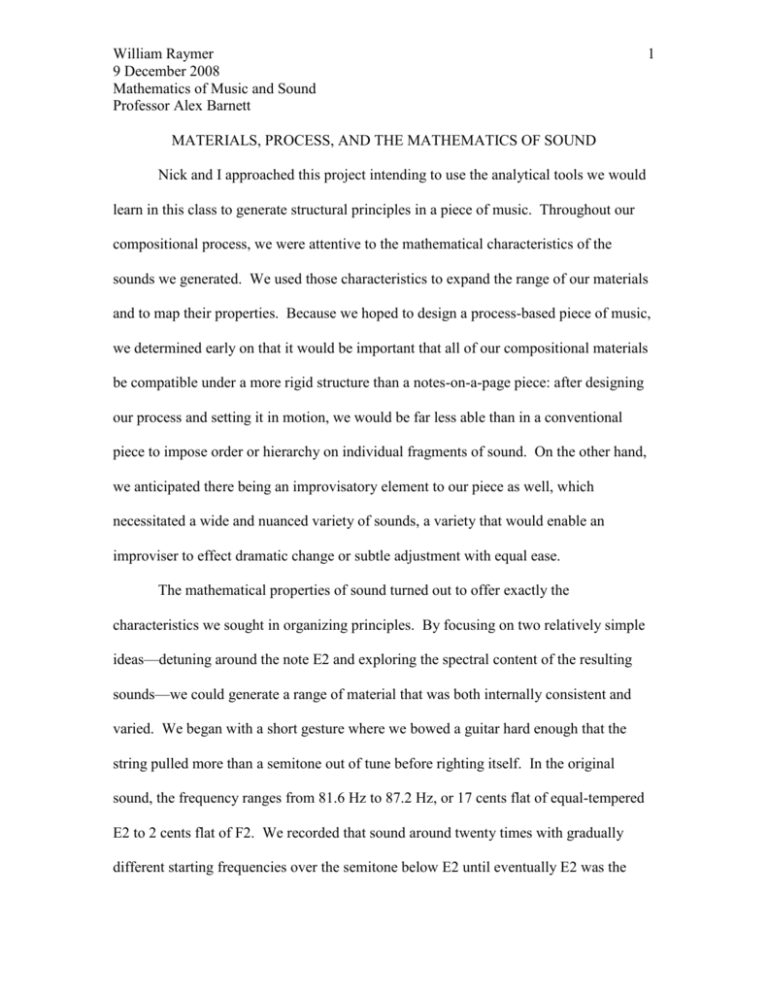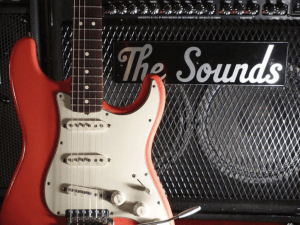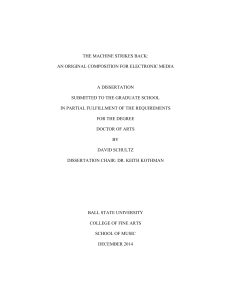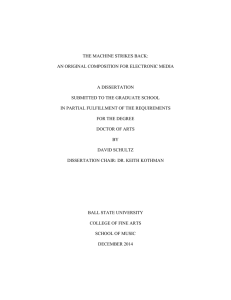MATERIALS, PROCESS, AND THE MATHEMATICS OF SOUND
advertisement

William Raymer 9 December 2008 Mathematics of Music and Sound Professor Alex Barnett 1 MATERIALS, PROCESS, AND THE MATHEMATICS OF SOUND Nick and I approached this project intending to use the analytical tools we would learn in this class to generate structural principles in a piece of music. Throughout our compositional process, we were attentive to the mathematical characteristics of the sounds we generated. We used those characteristics to expand the range of our materials and to map their properties. Because we hoped to design a process-based piece of music, we determined early on that it would be important that all of our compositional materials be compatible under a more rigid structure than a notes-on-a-page piece: after designing our process and setting it in motion, we would be far less able than in a conventional piece to impose order or hierarchy on individual fragments of sound. On the other hand, we anticipated there being an improvisatory element to our piece as well, which necessitated a wide and nuanced variety of sounds, a variety that would enable an improviser to effect dramatic change or subtle adjustment with equal ease. The mathematical properties of sound turned out to offer exactly the characteristics we sought in organizing principles. By focusing on two relatively simple ideas—detuning around the note E2 and exploring the spectral content of the resulting sounds—we could generate a range of material that was both internally consistent and varied. We began with a short gesture where we bowed a guitar hard enough that the string pulled more than a semitone out of tune before righting itself. In the original sound, the frequency ranges from 81.6 Hz to 87.2 Hz, or 17 cents flat of equal-tempered E2 to 2 cents flat of F2. We recorded that sound around twenty times with gradually different starting frequencies over the semitone below E2 until eventually E2 was the 2 point of destination rather the point of departure. When we analyzed the spectral content of our recording, we noticed that the bowing would excite certain higher strings on the guitar at different moments in its de- and retuning. Using that observation as a jumping-off point, we retuned the guitar in several different configurations in order to excite different strings with the bowing gesture. We employed an open tuning in E Major—all notes that were present as low partials in the spectral content of our E2—and observed that the top guitar strings activated more readily when they shared a fundamental with the bowed string (see Figure 1). We also retuned the top five strings to F Major, so they activated when the pitch of the bottom string bent up (see Figure 2). Both of these techniques produced a shimmering effect with clear, pure timbre that lingered well after the bowed string had stopped resonating. Also, in each technique, different upper strings would activate depending on where the lower string was bowed—this is no doubt due to the bow dampening certain antinodes in the string and exciting certain modes which would activate a specific upper partial. The characteristics of these sounds—many but subtle differences between them—fit with our project well. Using the notions of detuning and spectral analysis led us to generate several other sets of materials, also based on simple techniques with minor variation. We recorded high finger-picked harmonics on the guitar in several different E- and Fcentered tunings. We also tuned a violin to an open tuning in E and experimented with playing on the bridge, playing col legno, playing double stops, and playing harmonics. In addition, we manipulated several of our guitar sounds in Audacity to be twice and four 3 times as long (and consequently half and a quarter of the frequency), essentially generating artificial “missing fundamentals” for the harmonic series we used. Once we had a body of varied, internally consistent material, we needed a way to organize that material. We had been working through our composition with Michael Casey, who recommended that we use a program of his called SoundSpotter to narrow down the range of parameters within which we could organize our sounds. SoundSpotter takes sounds as input and matches them to an existing library of music. It can work off of live input through a microphone, or it can use its own output in a feedback loop to generate self-similar material from its library. We ended up with roughly twenty-three minutes of sound from our experimentation with the violin and guitar. We ran two copies of SoundSpotter simultaneously, beginning with our original bowed guitar sound as input, then asking each computer to identify material that was similar both to its own output and the other computer’s output. By setting one computer to divide up sound in a slightly longer interval than the other, we also produced a phasing effect and a sense of rhythm: the sound fragments begin in unison, slowly grow further out of sync with each other, and after twenty iterations, resynchronizes. SoundSpotter allows us to change its parameters on the fly, so we were able to manipulate parts of the process like whether the program matches sound based on timbre, pitch, or both (for a full list of parameters, see Figure 3). We could also instruct the program either to match the nearest possible sound or match sounds that are increasingly far afield from the input. In the recorded version of this piece, one computer begins matching input the nearest possible sound; the other begins matching input to the most distant possible sound, and the two gradually converge into a 4 middle ground before diverging toward the opposite process from which they began. This method results in another level of organization to the piece where the right and left sides of the stereo field slowly trade processes. It is significant that none of these methods of organization would have worked were our materials not based on mathematical systems. We drew from a variety of mathbased compositional processes, including phasing, spectral music, and microtonal music. Each of those processes provided enough structural similarity within our materials themselves that we could step back and let software take a major role in organizing our sounds in relation to each other. At the same time, the software was flexible enough to give us real-time improvisatory input. The mathematical principles take the role of deep structure in the recorded piece itself, but the piece would not be successful were the mathematical principles not present. Figure 1: 5 Figure 2: Figure 3: 6 Bibliography: Anderson, Julian. "Spectral music." Grove Music Online. Oxford Music Online. 9 Dec. 2008 <http://www.oxfordmusiconline.com/subscriber/article/grove/music/ 50982> Reich, Steve. “Music as a Gradual Process.” Columbia University. 1968. Accessed Online 9 Dec. 2008. <http://www.columbia.edu/ccnmtl/draft/ben/feld/mod1/ readings/reich.html> Listening: Feldman, Morton, “Piano, Violin, Viola, Cello.” Reich, Steve, “Violin Phase.” Reich, Steve, “It’s Gonna Rain” Scelsi, Giacinto, “Quatuor Cordes No. 3” Young, La Monte, Excerpt "31 | 69 c. 12:17:33-12:25:33 PM NYC" & "31 | 69 C. 12:17:33-12:24:33 PM NYC"








